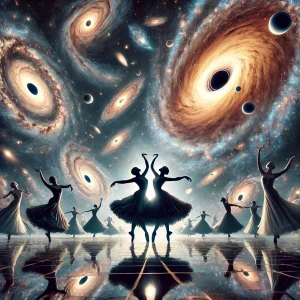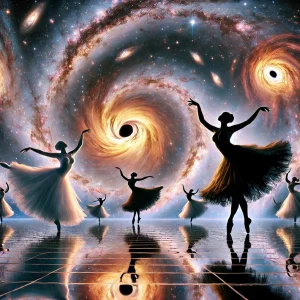Imagine the universe as an infinite ballroom where celestial bodies twirl and glide in an eternal dance. At the heart of this grand cosmic performance are the enigmatic black holes, the mysterious and powerful dancers leading the waltz of the galaxies. These black holes, with their incomprehensible gravitational pull and unfathomable depths, hold secrets that have fascinated scientists and dreamers alike. Join us on a journey to explore the mesmerizing dance of black holes, unraveling the rhythm and grace they bring to the cosmos.

The Cosmic Waltz: Black Holes as Celestial Ballerinas
In the grand theater of the universe, black holes perform with an elegance that belies their fearsome reputation. Picture them as celestial ballerinas, moving with a grace that captures the imagination. Their dance begins with the collapse of massive stars, a dramatic pirouette that transforms them into singularities. This transformation sets the stage for a performance that spans millennia, as they draw in matter and energy with a captivating allure, much like a prima ballerina commanding the spotlight.
These black holes are not solitary performers; they often dance in pairs or even larger ensembles. When two black holes meet, they engage in a gravitational tango, spiraling ever closer in a dizzying whirl before merging in a cataclysmic finale. This cosmic ballet is not just a spectacle for the mind’s eye; it produces ripples in spacetime known as gravitational waves, which scientists have only recently begun to detect. The discovery of these waves has opened a new window into the universe, allowing us to listen to the silent symphony of black holes.
Even at the centers of galaxies, black holes lead intricate dances. Supermassive black holes, millions to billions of times the mass of our Sun, anchor these galaxies like grand ballerinas anchoring the corps de ballet. Their gravitational influence orchestrates the motion of stars and gas, creating patterns and structures that are as beautiful as they are complex. In this cosmic waltz, black holes are both the performers and the choreographers, shaping the very fabric of the universe.

Heartbeats of the Universe: A Black Hole’s Rhythmic Dance
A black hole’s dance is more than just a visual spectacle; it is a rhythmic heartbeat that pulses through the universe. As matter spirals into a black hole, it forms an accretion disk that radiates energy, producing rhythmic pulses of light and other electromagnetic waves. These emissions can be likened to the rhythmic footsteps of a dancer, marking time in the vast expanse of space. Observing these pulses allows astronomers to measure the properties of black holes, providing insights into their mass, spin, and the nature of the infalling matter.
In binary systems, where a black hole partners with a companion star, the dance becomes even more intricate. The black hole’s immense gravity draws material from its partner, creating jets of particles that shoot out into space at nearly the speed of light. These jets are like the dramatic lifts and spins in a ballroom dance, showcasing the dynamic interplay between the black hole and its stellar companion. This interaction can cause the black hole to emit periodic bursts of X-rays, which can be detected by space telescopes, offering a glimpse into the intimate details of their celestial dance.
Furthermore, the rhythmic dance of black holes can influence the very evolution of galaxies. The energy and momentum carried away by gravitational waves during black hole mergers can alter the orbits of stars and gas, redistributing matter across the galaxy. This process can trigger star formation or even expel gas, shaping the future development of the galaxy. In this way, black holes do not merely dance to their own tune; they set the tempo for the cosmic ballet, influencing the rhythm of the universe itself.
As we gaze into the night sky, we can now appreciate the grand performance taking place within the darkness. Black holes, with their powerful and enigmatic presence, are the celestial ballerinas of the cosmos. They dance not only to their own rhythm but also to the beat of the entire universe, shaping the structure and destiny of galaxies. Through their cosmic waltz, we are reminded of the beauty and complexity of the universe, a never-ending dance that beckons us to keep watching, wondering, and exploring. So the next time you look up at the stars, imagine the black holes waltzing gracefully in the vast ballroom of space, leading the cosmic dance with elegance and power.









